Numerical Study of Circular Concrete Filled Steel Tubes Subjected to Pure Torsion
Abstract
:1. Introduction
2. Research Significance
3. Material Models
3.1. Stress-Strain Model of Steel
3.2. Compressive and Tensile Stress-Strain Model of Concrete
4. Modelling
5. Verifications
5.1. Moment-Rotation Curve
5.1.1. Comparing with the Test Results Obtained by Beck and Kiyomiya
5.1.2. Comparing with the Experimental Results Obtained by Han and Zhong
5.1.3. Comparing with the Experimental Data Obtained by Le et al.
6. Load Transferring Mechanism
7. Parametric Study
7.1. Effect of Yield Strength of Steel on the Torsional Behaviour of CFSTs
7.2. Effect of Concrete Strength on the Torsional Behavior of CFSTs
7.3. Analyses of the Numerical Results
8. Correlation Analyses
9. Conclusions
- The distribution of stress exhibited a mechanism of torsional moment transferring. Moving from one end section to the middle section of the CFST, the moment sustained by steel tube decreased while that of concrete increased. The stress of steel at the end regions was greater than that at the middle region. On the contrary, the stress on concrete at the end regions was smaller than that at the middle region.
- Concrete strength marginally affected the moment-rotation behavior of the CFSTs. Improving the behavior and capacity of the CFST was not the main function of concrete, while its main function was to prevent buckling of steel tubes and thus to make steel tubes work more effectively.
- The steel strength did not affect the elastic stiffness; however, it decisively affected the nominal yield strength and the plastic behavior of the CFSTs. When the yield steel strength increased from 235 to 420 MPa, the nominal yield torsional moment of the CFSTs increased by approximately 50%.
- Correlation analyses were performed to see the correlation degree between the mechanical properties and parameters of the CFSTs. The results showed that the parameters related to the steel tube had higher correlation coefficients than those related to concrete. Interestingly, the yield torsional moment of steel tube had the strongest correlation with the nominal yield moments of the CFSTs followed by D/t ratio, while the compressive strength of concrete came in the last position.
Author Contributions
Funding
Institutional Review Board Statement
Informed Consent Statement
Data Availability Statement
Conflicts of Interest
Abbreviations
| D | diameter of steel tube |
| t | thickness of steel tube |
| L | length of CFST |
| L′ | length of rigid blocks |
| Es | elastic modulus of steel |
| fy | yield strength of steel |
| fu | ultimate strength of steel |
| εy | yield strain of steel |
| εu | ultimate strain of steel |
| εc | strain of concrete |
| εo | strain corresponding to maximum stress of concrete |
| f′c | maximum stress of concrete |
| Ec | elastic modulus of concrete |
| μ | coefficient of friction |
| p | normal pressure |
| ξ | confinement factor |
| τy | yield shear strength of steel |
| ke | elastic stiffness |
| kp | plastic stiffness |
| Mo | moment at the intersection of the plastic branch and the vertical axis |
| θ | rotation |
| Ws | torsional inertia modulus of cross section of steel tube |
| As | cross sectional area of steel tube |
| Ac | cross sectional area of concrete |
| Me | elastic moment |
| My | yield moment |
| X, Y | variables |
| , | means of the variables X and Y |
References
- Dundu, M. Compressive strength of circular concrete filled steel tube columns. Thin-Walled Struct. 2012, 56, 62–70. [Google Scholar] [CrossRef]
- Xu, L.; Zhou, P.; Chi, Y.; Huang, L.; Ye, J.; Yu, M. Performance of the high-strength self-stressing and self-compacting concrete-filled steel tube columns subjected to the uniaxial compression. Int. J. Civ. Eng. 2017, 16, 1069–1083. [Google Scholar] [CrossRef] [Green Version]
- Van Cao, V. Experimental Behaviour of recycled aggregate concrete-filled steel tubes under axial loading. Int. J. Civ. Eng. 2019, 17, 1341–1351. [Google Scholar] [CrossRef]
- Tao, Z.; Uy, B.; Han, L.-H.; Wang, Z.-B. Analysis and design of concrete-filled stiffened thin-walled steel tubular columns under axial compression. Thin-Walled Struct. 2009, 47, 1544–1556. [Google Scholar] [CrossRef]
- Han, L.-H.; He, S.-H.; Liao, F.-Y. Performance and calculations of concrete filled steel tubes (CFST) under axial tension. J. Constr. Steel Res. 2011, 67, 1699–1709. [Google Scholar] [CrossRef]
- Chen, J.; Wang, J.; Li, W. Experimental behaviour of reinforced concrete-filled steel tubes under eccentric tension. J. Constr. Steel Res. 2017, 136, 91–100. [Google Scholar] [CrossRef]
- Van Cao, V.; Le, Q.D.; Nguyen, P.T. Experimental behaviour of concrete-filled steel tubes under cyclic axial compression. Adv. Struct. Eng. 2019, 23, 74–88. [Google Scholar] [CrossRef]
- Elchalakani, M.; Zhao, X.-L.; Grzebieta, R. Concrete-filled steel circular tubes subjected to constant amplitude cyclic pure bending. Eng. Struct. 2004, 26, 2125–2135. [Google Scholar] [CrossRef]
- Han, L.-H.; Hou, C.; Zhao, X.-L.; Rasmussen, K.J.R. Behaviour of high-strength concrete filled steel tubes under transverse impact loading. J. Constr. Steel Res. 2014, 92, 25–39. [Google Scholar] [CrossRef]
- Du, G.; Babic, M.; Wu, F.; Zeng, X.; Bie, X.-M. Experimental and numerical studies on concrete filled circular steel tubular (cfcst) members under impact loads. Int. J. Civ. Eng. 2019, 17, 1211–1226. [Google Scholar] [CrossRef]
- Dey, P.; Gupta, R.K.; Laskar, A.I. Numerical and Experimental Investigations of Different Cross-Sectional Configuration of Plain Concrete and CFST Short Columns under Axial Compression. Int. J. Civ. Eng. 2019, 17, 1585–1601. [Google Scholar] [CrossRef]
- Li, G.; Chen, B.; Yang, Z.; Feng, Y. Experimental and numerical behaviour of eccentrically loaded high strength concrete filled high strength square steel tube stub columns. Thin-Walled Struct. 2018, 127, 483–499. [Google Scholar] [CrossRef]
- Skalomenos, K.; Hayashi, K.; Nishi, R.; Inamasu, H.; Nakashima, M. Experimental Behavior of Concrete-Filled Steel Tube Columns Using Ultrahigh-Strength Steel. J. Struct. Eng. 2016, 142, 04016057. [Google Scholar] [CrossRef]
- Lam, D.; Gardner, L.; Burdett, M. Behaviour of axially loaded concrete filled stainless steel elliptical stub columns. Adv. Struct. Eng. 2010, 13, 493–500. [Google Scholar] [CrossRef]
- Tao, Z.; Uy, B.; Liao, F.-Y.; Han, L.-H. Nonlinear analysis of concrete-filled square stainless steel stub columns under axial compression. J. Constr. Steel Res. 2011, 67, 1719–1732. [Google Scholar] [CrossRef]
- Xiang, X.; Cai, C.; Zhao, R.; Peng, H. Numerical analysis of recycled aggregate concrete-filled steel tube stub columns. Adv. Struct. Eng. 2016, 19, 717–729. [Google Scholar] [CrossRef]
- Yang, Y.-F.; Han, L.-H.; Zhu, L.-T. Experimental performance of recycled aggregate concrete-filled circular steel tubular columns subjected to cyclic flexural loadings. Adv. Struct. Eng. 2009, 12, 183–194. [Google Scholar] [CrossRef]
- Ren, Q.-X.; Zhou, K.; Hou, C.; Tao, Z.; Han, L.-H. Dune sand concrete-filled steel tubular (CFST) stub columns under axial compression: Experiments. Thin-Walled Struct. 2018, 124, 291–302. [Google Scholar] [CrossRef]
- Ostrowski, K.; Dudek, M.; Sadowski, Ł. Compressive behaviour of concrete-filled carbon fiber-reinforced polymer steel composite tube columns made of high performance concrete. Compos. Struct. 2020, 234, 111668. [Google Scholar] [CrossRef]
- Yu, Q.; Tao, Z.; Wu, Y.-X. Experimental behaviour of high performance concrete-filled steel tubular columns. Thin-Walled Struct. 2008, 46, 362–370. [Google Scholar] [CrossRef]
- Elremaily, A.; Azizinamini, A. Behavior and strength of circular concrete-filled tube columns. J. Constr. Steel Res. 2002, 58, 1567–1591. [Google Scholar] [CrossRef]
- Alatshan, F.; Osman, S.A.; Hamid, R.; Mashiri, F. Stiffened concrete-filled steel tubes: A systematic review. Thin-Walled Struct. 2020, 148, 106590. [Google Scholar] [CrossRef]
- Ansari, M.; Jeddi, M.; Badaruzzaman, W.; Tahir, M.; Osman, S.; Hosseinpour, E. A numerical investigation on the through rib stiffener beam to concrete-filled steel tube column connections subjected to cyclic loading. Eng. Sci. Technol. Int. J. 2020, 24, 728–735. [Google Scholar] [CrossRef]
- Han, L.-H.; Wang, W.-H.; Yu, H.-X. Experimental behaviour of reinforced concrete (RC) beam to concrete-filled steel tubular (CFST) column frames subjected to ISO-834 standard fire. Eng. Struct. 2010, 32, 3130–3144. [Google Scholar] [CrossRef]
- Han, L.-H.; Wang, W.-H.; Yu, H.-X. Analytical behaviour of RC beam to CFST column frames subjected to fire. Eng. Struct. 2012, 36, 394–410. [Google Scholar] [CrossRef]
- Nie, J.-G.; Wang, Y.-H.; Fan, J.-S. Experimental study on seismic behavior of concrete filled steel tube columns under pure torsion and compression–torsion cyclic load. J. Constr. Steel Res. 2012, 79, 115–126. [Google Scholar] [CrossRef]
- Nie, J.-G.; Wang, Y.-H.; Fan, J.-S. Experimental research on concrete filled steel tube columns under combined compression-bending-torsion cyclic load. Thin-Walled Struct. 2013, 67, 1–14. [Google Scholar] [CrossRef]
- Lee, E.-T.; Yun, B.H.; Shim, H.J.; Chang, K.H.; Lee, G.C. Torsional behavior of concrete-filled circular steel tube columns. J. Struct. Eng. 2009, 135, 1250–1258. [Google Scholar] [CrossRef]
- Wang, Y.-H.; Nie, J.-G.; Fan, J.-S. Fiber beam-column element for circular concrete filled steel tube under axial–flexure–torsion combined load. J. Constr. Steel Res. 2014, 95, 10–21. [Google Scholar] [CrossRef]
- Xin, N.; Yu-Hang, W.; Shuo, L.; Ju, C. Coupled bending-shear-torsion bearing capacity of concrete filled steel tube short columns. Thin-Walled Struct. 2018, 123, 305–316. [Google Scholar] [CrossRef]
- Han, L.-H.; Yao, G.-H.; Tao, Z. Behaviors of concrete-filled steel tubular members subjected to combined loading. Thin-Walled Struct. 2007, 45, 600–619. [Google Scholar] [CrossRef]
- Wang, Y.-H.; Wang, W.; Chen, J. Seismic behavior of steel tube confined RC columns under compression-bending-torsion combined load. J. Constr. Steel Res. 2018, 143, 83–96. [Google Scholar] [CrossRef]
- Wang, P.; Han, Q.; Du, X. Seismic performance of circular RC bridge columns with flexure–torsion interaction. Soil Dyn. Earthq. Eng. 2014, 66, 13–30. [Google Scholar] [CrossRef]
- Ren, Q.-X.; Han, L.-H.; Hou, C.; Tao, Z.; Li, S. Concrete-encased CFST columns under combined compression and torsion: Experimental investigation. J. Constr. Steel Res. 2017, 138, 729–741. [Google Scholar] [CrossRef]
- Wang, Y.-H.; Zhou, X.-H.; Deng, R.; Lan, Y.-S.; Luo, W.; Li, P.; Yang, Q.-S.; Ke, K. Coupled ultimate capacity of CFRP confined concrete-filled steel tube columns under compression-bending-torsion load. Structures 2021, 31, 558–575. [Google Scholar] [CrossRef]
- Beck, J.; Kiyomiya, O. Fundemental pure torsional properties of concrete filled circular steel tubes. Doboku Gakkai Ronbunshu 2003, 60, 285–296. [Google Scholar] [CrossRef] [Green Version]
- Han, L.-H.; Yao, G.-H.; Tao, Z. Performance of concrete-filled thin-walled steel tubes under pure torsion. Thin-Walled Struct. 2007, 45, 24–36. [Google Scholar] [CrossRef]
- Wang, Y.-H.; Guo, Y.-F.; Liu, J.-P.; Zhou, X.-H. Experimental study on torsion behavior of concrete filled steel tube columns subjected to eccentric compression. J. Constr. Steel Res. 2017, 129, 119–128. [Google Scholar] [CrossRef]
- Wang, Y.-H.; Lu, G.-B.; Zhou, X.-H. Experimental study of the cyclic behavior of concrete-filled double skin steel tube columns subjected to pure torsion. Thin-Walled Struct. 2018, 122, 425–438. [Google Scholar] [CrossRef]
- Ding, F.-X.; Sheng, S.-J.; Yu, Y.-J.; Yu, Z.-W. Mechanical behaviors of concrete-filled rectangular steel tubular under pure torsion. Steel Compos. Struct. 2019, 31, 291–301. [Google Scholar] [CrossRef]
- Ding, F.-X.; Fu, Q.; Wen, B.; Zhou, Q.-S.; Liu, X.-M. Behavior of circular concrete-filled steel tubular columns under pure torsion. Steel Compos. Struct. 2018, 26, 501–511. [Google Scholar] [CrossRef]
- Chen, J.; Jin, W.L.; Fu, J. Experimental investigation of thin-walled centrifugal concrete-filled steel tubes under torsion. Thin-Walled Struct. 2008, 46, 1087–1093. [Google Scholar] [CrossRef]
- Chen, J.; Chen, J.; Jin, W.L. Design of thin-walled centrifugal concrete-filled steel tubes under torsion. Thin-Walled Struct. 2009, 47, 271–276. [Google Scholar] [CrossRef]
- Nie, X.; Wang, W.; Wang, Y.-H.; Yu, J.; Hou, C. Ultimate torsional capacity of steel tube confined reinforced concrete columns. J. Constr. Steel Res. 2019, 160, 207–222. [Google Scholar] [CrossRef]
- Majed, M.M.; Tavakkolizadeh, M.; Allawi, A.A. Finite element analysis of rectangular RC beams strengthened with FRP laminates under pure torsion. Struct. Concr. 2021. [Google Scholar] [CrossRef]
- Onge, J.S.; Fam, A. Torsional Behavior of Circular Concrete-Filled FRP Tubes. J. Compos. Constr. 2021, 25, 04021013. [Google Scholar] [CrossRef]
- Smith, M. ABAQUS/Standard User’s Manual; Dassault Systèmes Simulia Corp: Providence, RI, USA, 2017. [Google Scholar]
- CEN. Eurocode 2: Design of Concrete Structures-Part 1-1: General Rules and Rules for Buildings; European Committee for Standardization: Brussels, Belgium, 2004. [Google Scholar]
- Tao, Z.; Wang, Z.-B.; Yu, Q. Finite element modelling of concrete-filled steel stub columns under axial compression. J. Constr. Steel Res. 2013, 89, 121–131. [Google Scholar] [CrossRef]
- Hognestad, E. A Study of Combined Bending Axial Load in Reinforced Concrete Members; Bulletin Series, No. 399; Engineering Experimental Station, The University of Illinois: Urbana, IL, USA, 1951; Volume 49. [Google Scholar]
- ACI. Building Code Requirements for Structural Concrete (ACI 318M-08) and Commentary; American Concrete Institute: Farmington Hills, MI, USA, 2008. [Google Scholar]
- Park, R.; Paulay, T. (Eds.) Reinforced Concrete Structures; John Wiley & Sons: New York, NY, USA; London, UK; Sydney, Australia; Toronto, ON, Canada, 1975. [Google Scholar]
- Li, S.; Han, L.-H.; Hou, C. Concrete-encased CFST columns under combined compression and torsion: Analytical behaviour. J. Constr. Steel Res. 2018, 144, 236–252. [Google Scholar] [CrossRef]
- Ellobody, E. Numerical modelling of fibre reinforced concrete-filled stainless steel tubular columns. Thin-Walled Struct. 2013, 63, 1–12. [Google Scholar] [CrossRef]
- Le Hoang, A.; Fehling, E. Numerical study of circular steel tube confined concrete (STCC) stub columns. J. Constr. Steel Res. 2017, 136, 238–255. [Google Scholar] [CrossRef]
- Baltay, P.; Gjelsvik, A. Coefficient of friction for steel on concrete at high normal stress. J. Mater. Civ. Eng. 1990, 2, 46–49. [Google Scholar] [CrossRef]
- Lam, D.; Dai, X.; Han, L.-H.; Ren, Q.-X.; Li, W. Behaviour of inclined, tapered and STS square CFST stub columns subjected to axial load. Thin-Walled Struct. 2012, 54, 94–105. [Google Scholar] [CrossRef]
- Schneider, S.P. Axially loaded concrete-filled steel tubes. J. Struct. Eng. 1998, 124, 1125–1138. [Google Scholar] [CrossRef]
- Rabbat, B.G.; Russell, H.G. Friction coefficient of steel on concrete or grout. J. Struct. Eng. 1985, 111, 505–515. [Google Scholar] [CrossRef]
- Qiu, W.; McCann, F.; Espinos, A.; Romero, M.; Gardner, L. Numerical analysis and design of slender concrete-filled elliptical hollow section columns and beam-columns. Eng. Struct. 2017, 131, 90–100. [Google Scholar] [CrossRef]
- Dai, X.; Lam, D.; Jamaluddin, N.; Ye, J. Numerical analysis of slender elliptical concrete filled columns under axial compression. Thin-Walled Struct. 2014, 77, 26–35. [Google Scholar] [CrossRef]
- Espinos, A.; Romero, M.L.; Hospitaler, A. Advanced model for predicting the fire response of concrete filled tubular columns. J. Constr. Steel Res. 2010, 66, 1030–1046. [Google Scholar] [CrossRef]
- Han, L.; Zhong, S. The studies of pure torsion problem for concrete filled steel tube. Ind. Constr. 1995, 92, 562–573. [Google Scholar]
- Le, K.B.; Van Cao, V.; Cao, H.X. Circular concrete filled thin-walled steel tubes under pure torsion: Experiments. Thin-Walled Struct. 2021, 164, 107874. [Google Scholar] [CrossRef]
- Park, R. Ductility evaluation from laboratory and analytical testing. In Proceedings of the 9th World Conference on Earthquake Engineering, Tokyo, Japan, 2–9 August 1988. [Google Scholar]
- Spiegel, M.R. (Ed.) Theory and Problems of Statistics; McGraw-Hil: London, UK, 1990. [Google Scholar]
- Jones, M.C.; Gibbons, J.D.; Chakraborti, S. Nonparametric statistical inference. J. R. Stat. Soc. Ser. A Stat. Soc. 1993, 156, 503. [Google Scholar] [CrossRef]
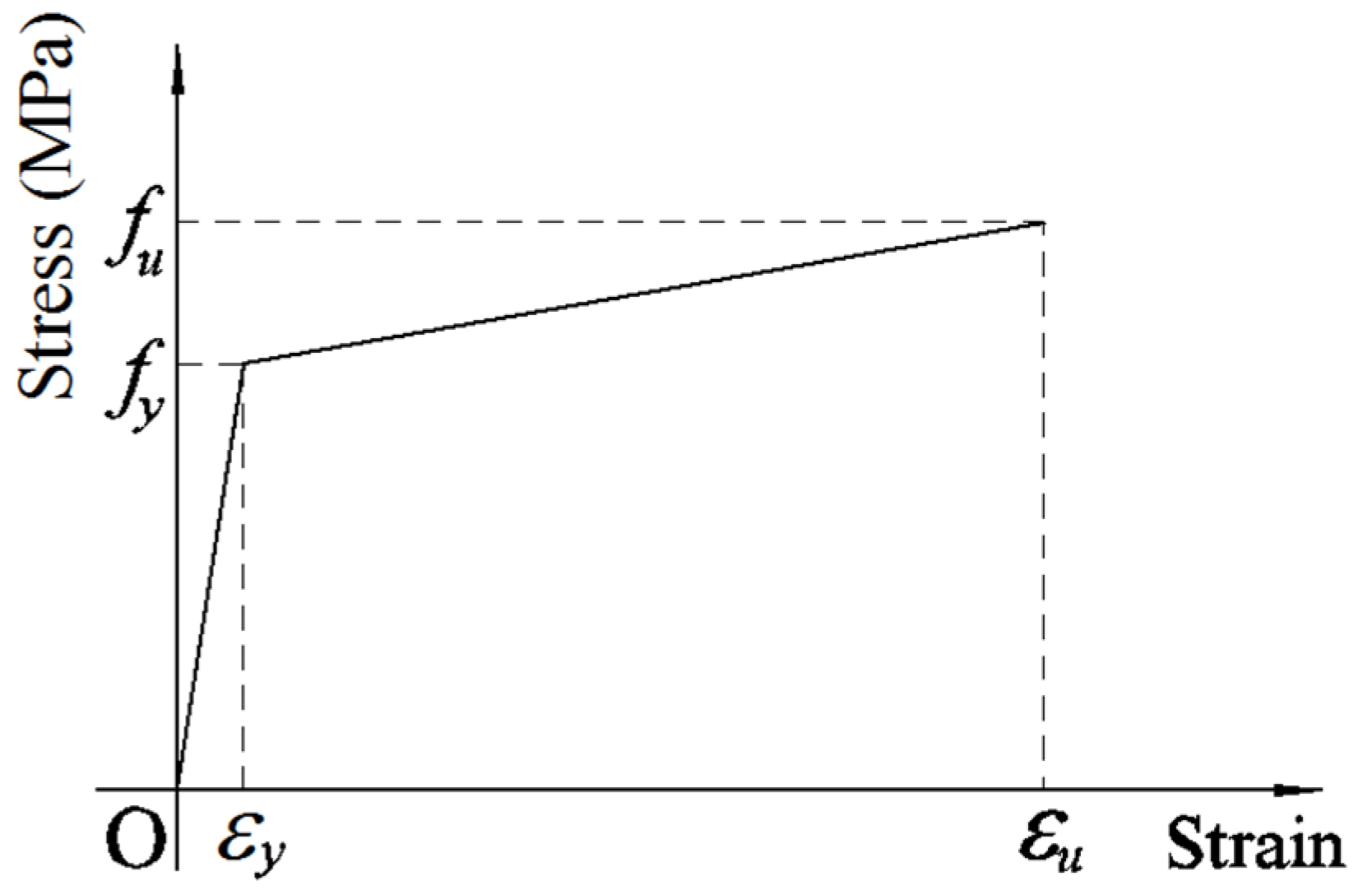
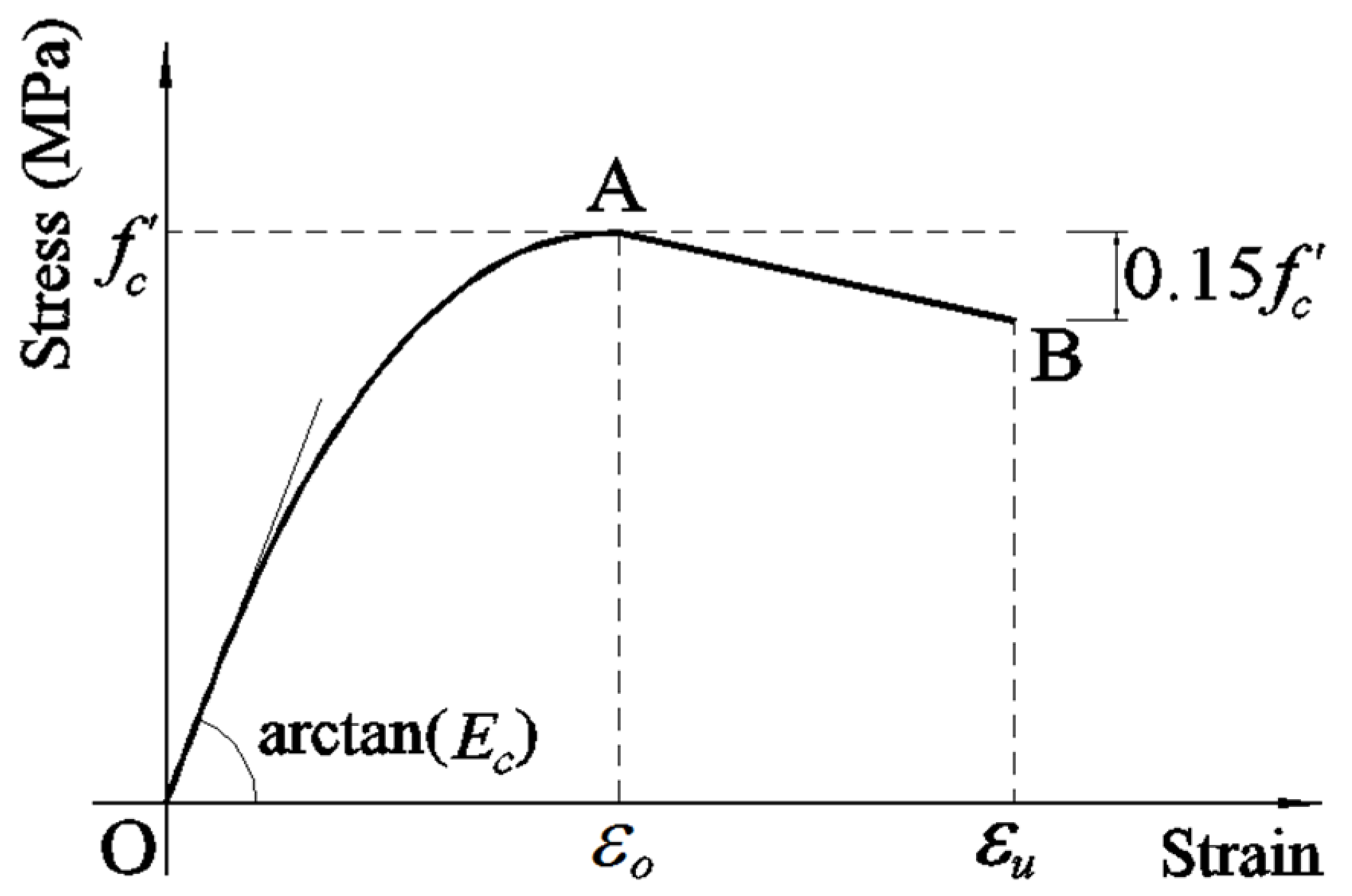

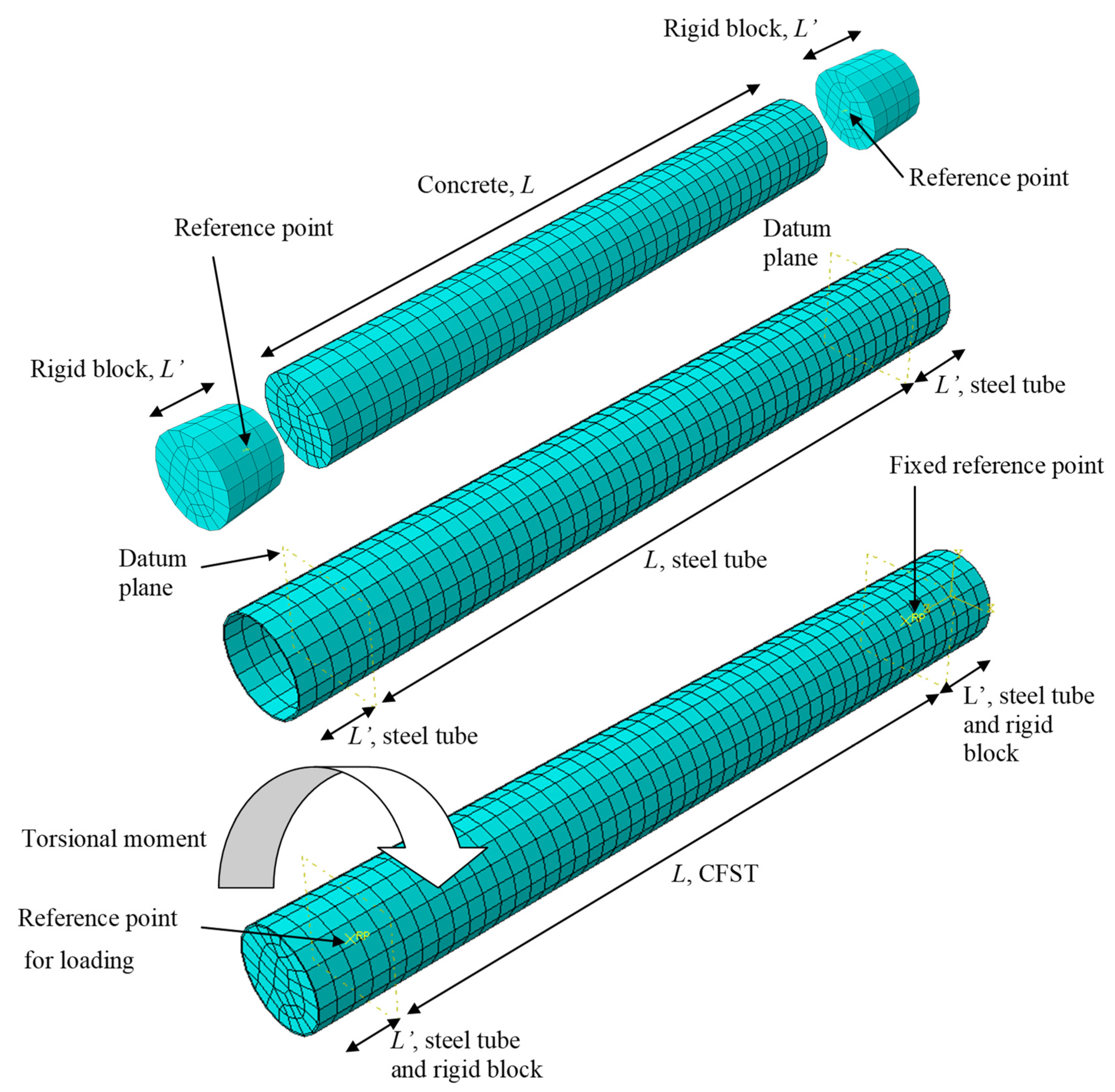
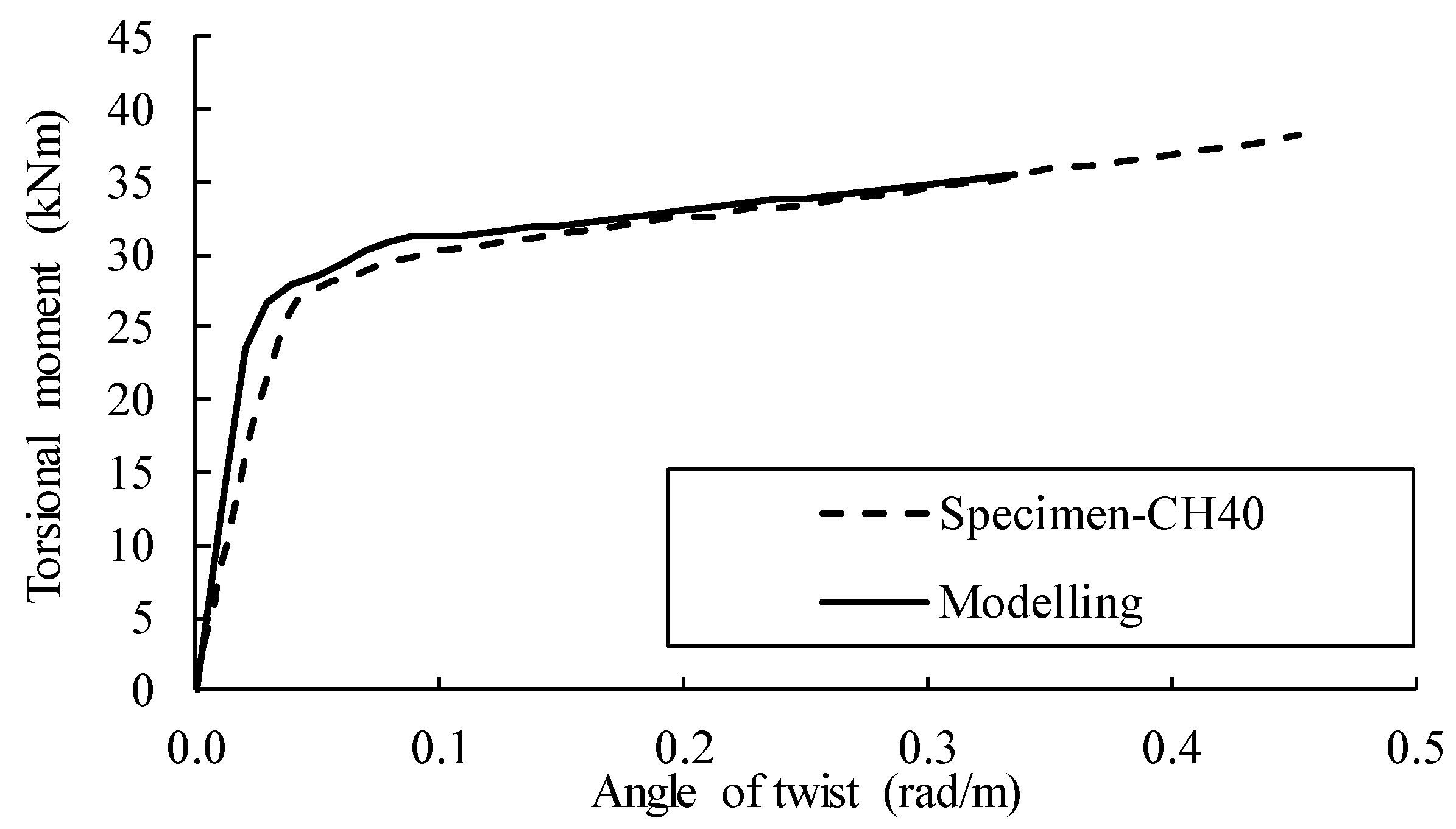
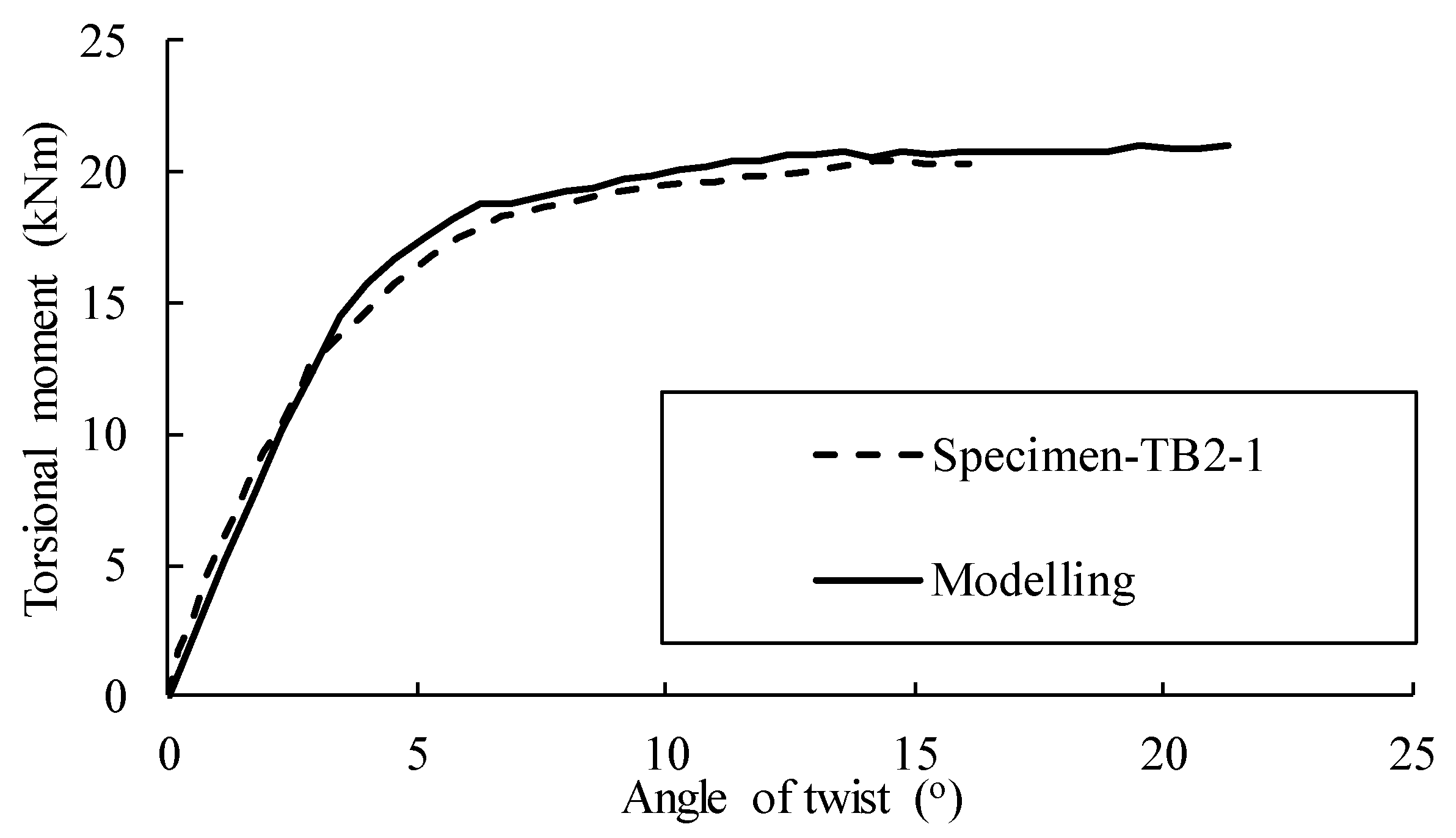
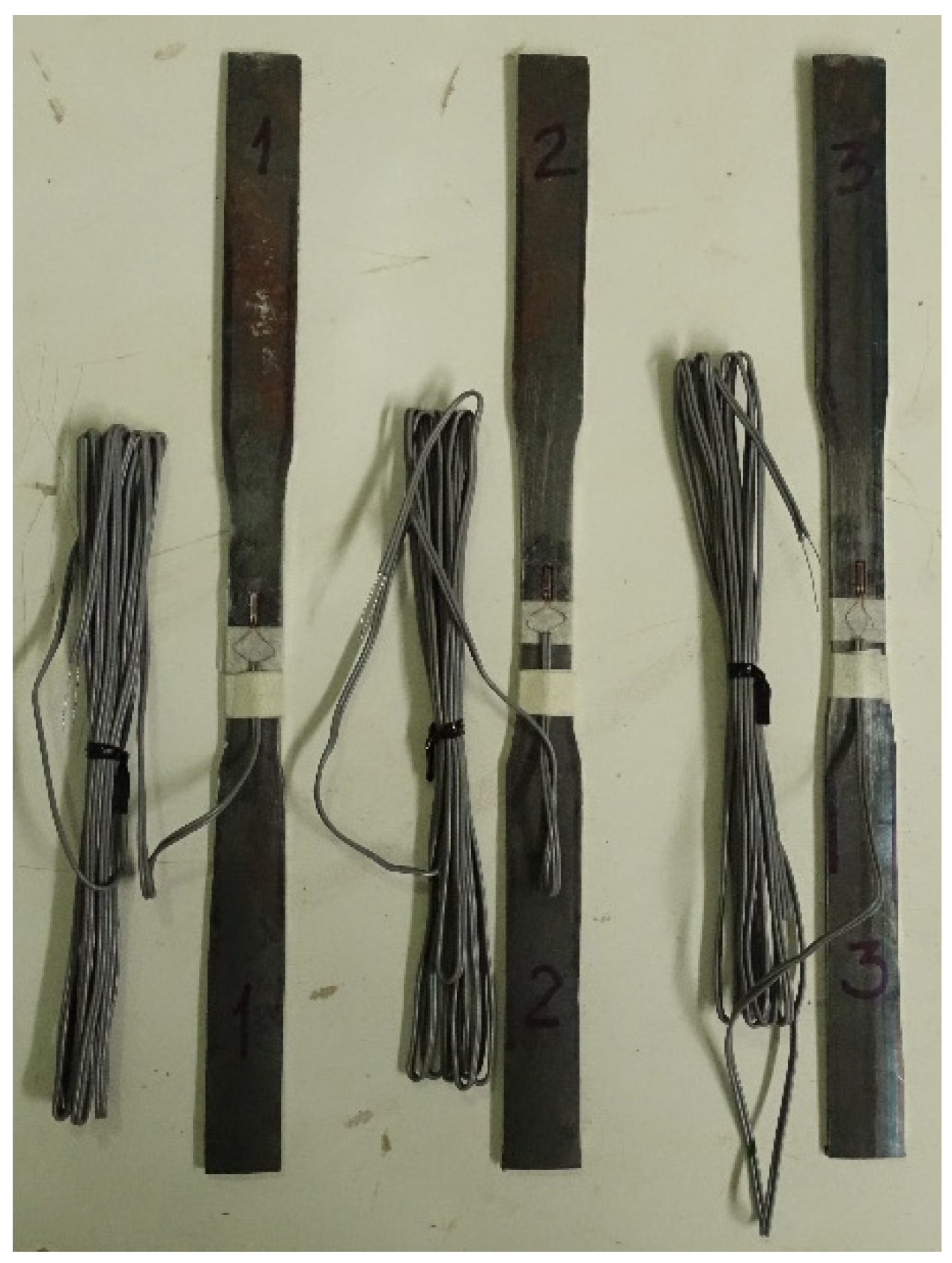
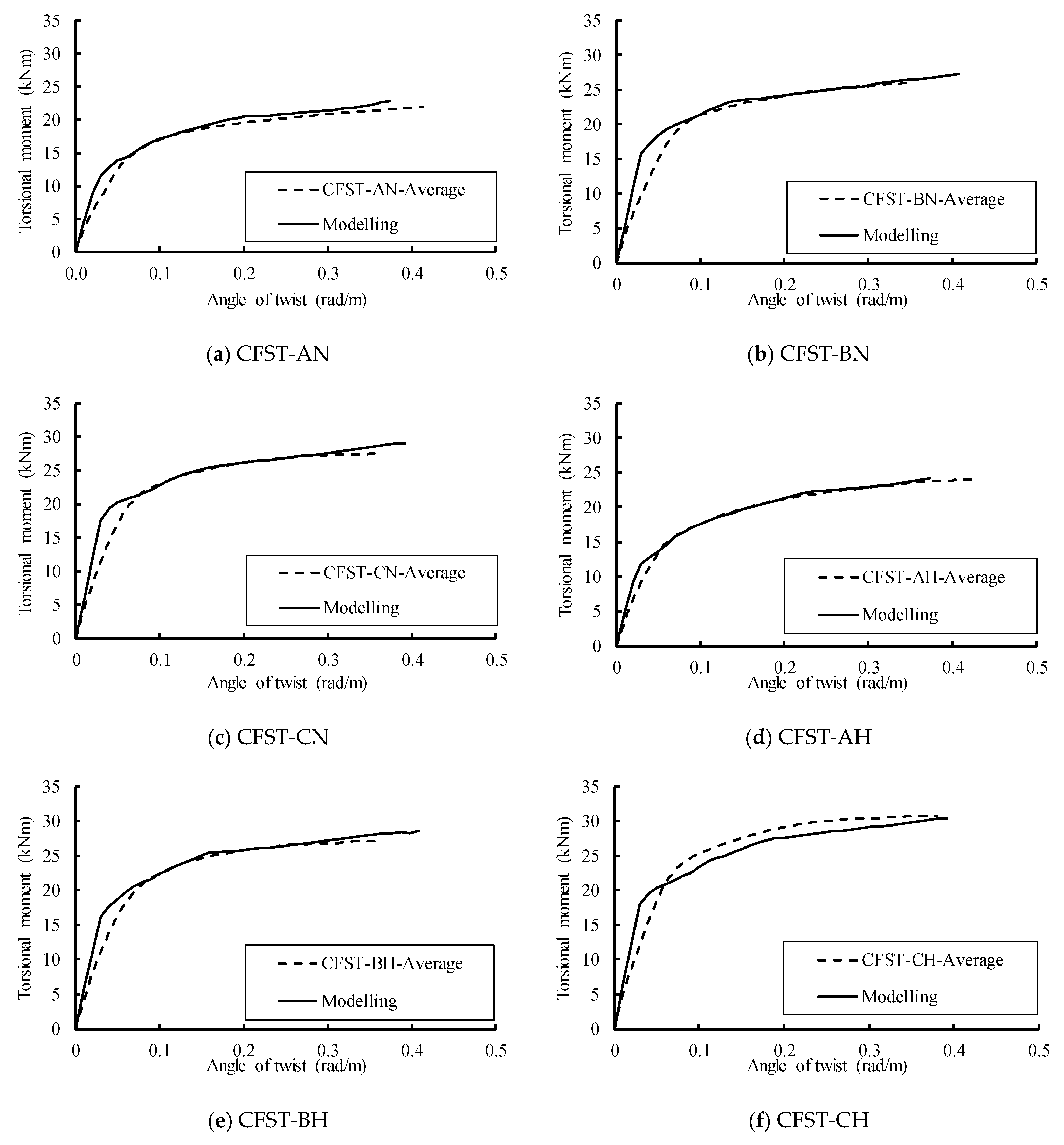
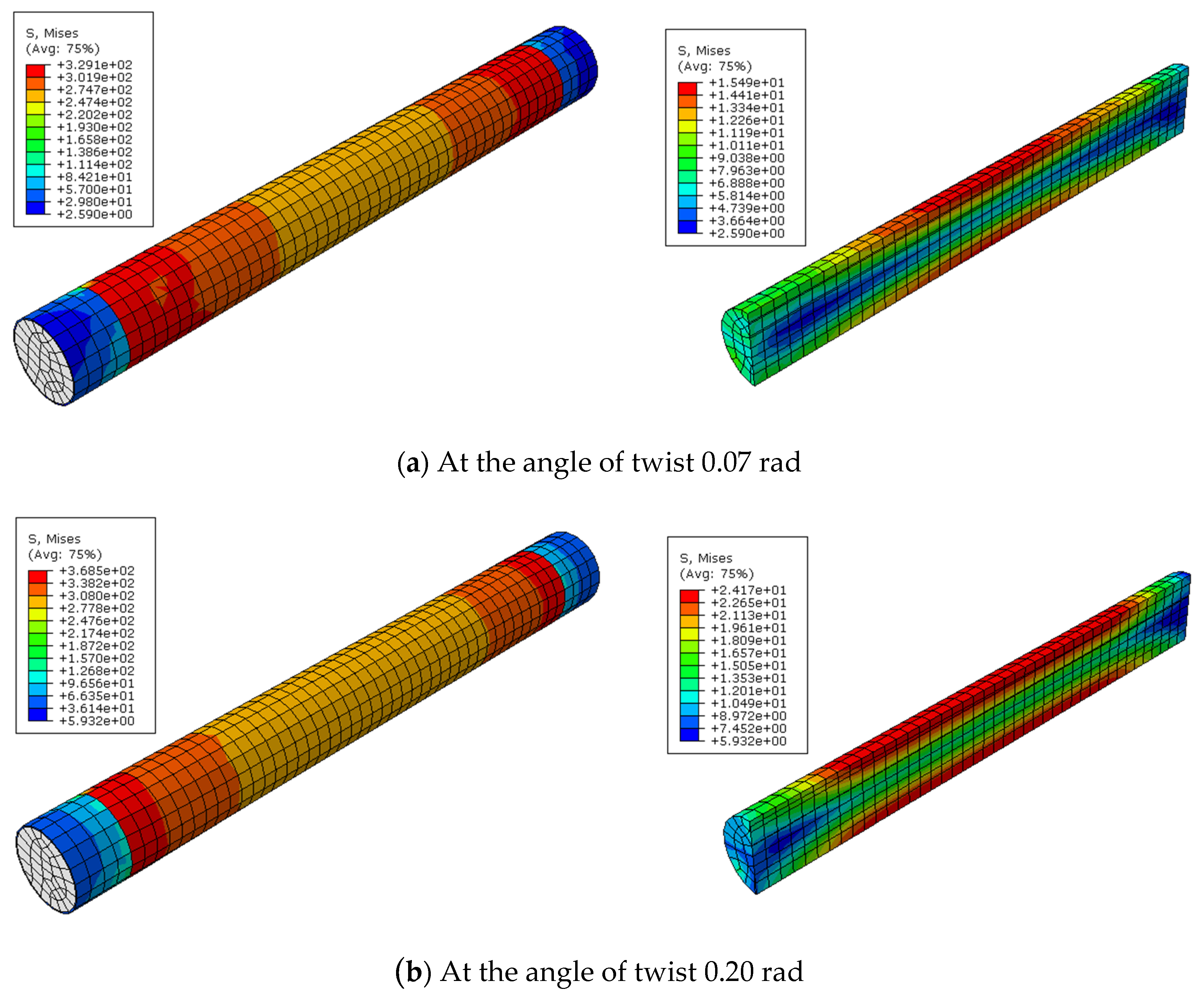
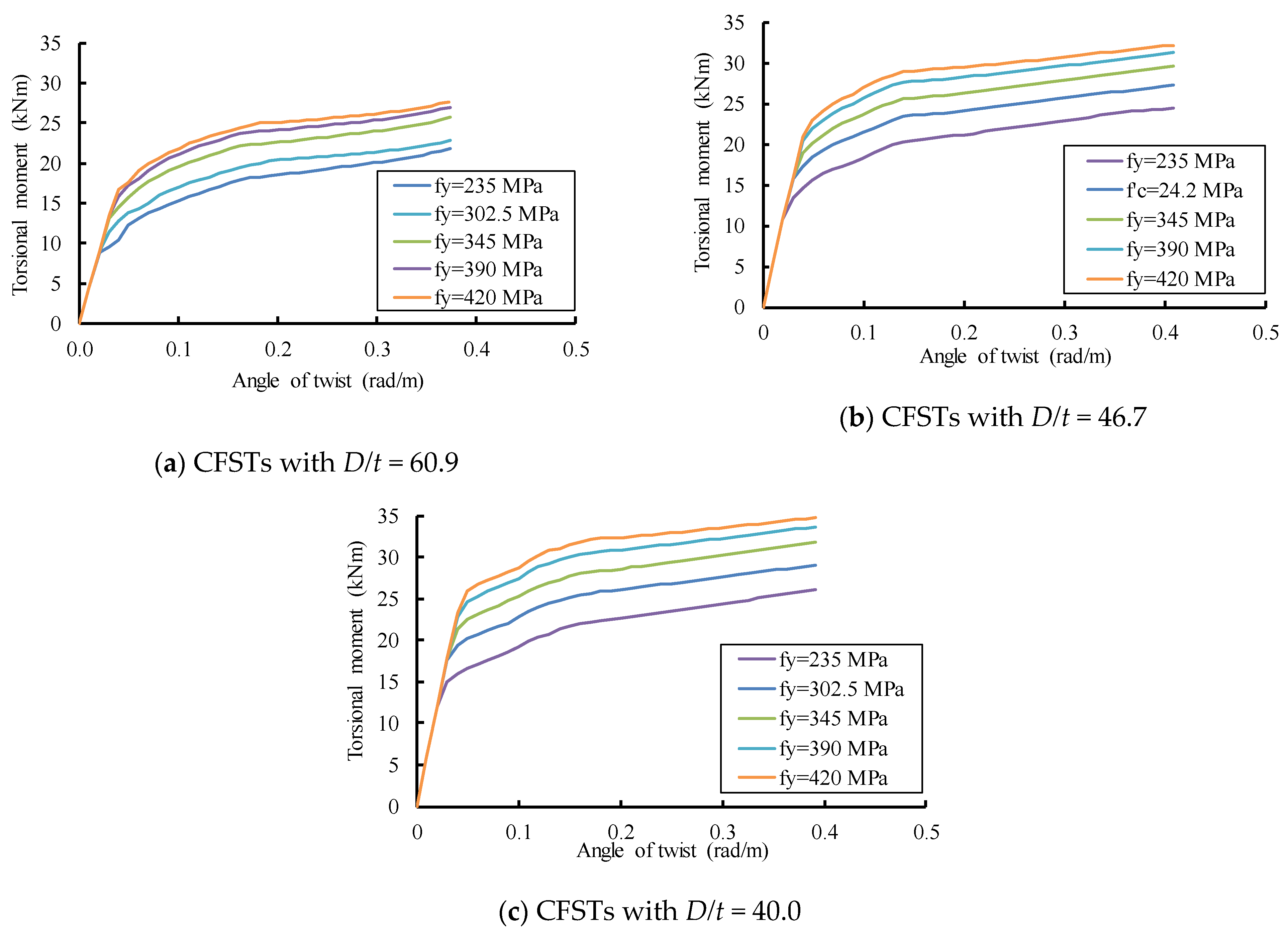
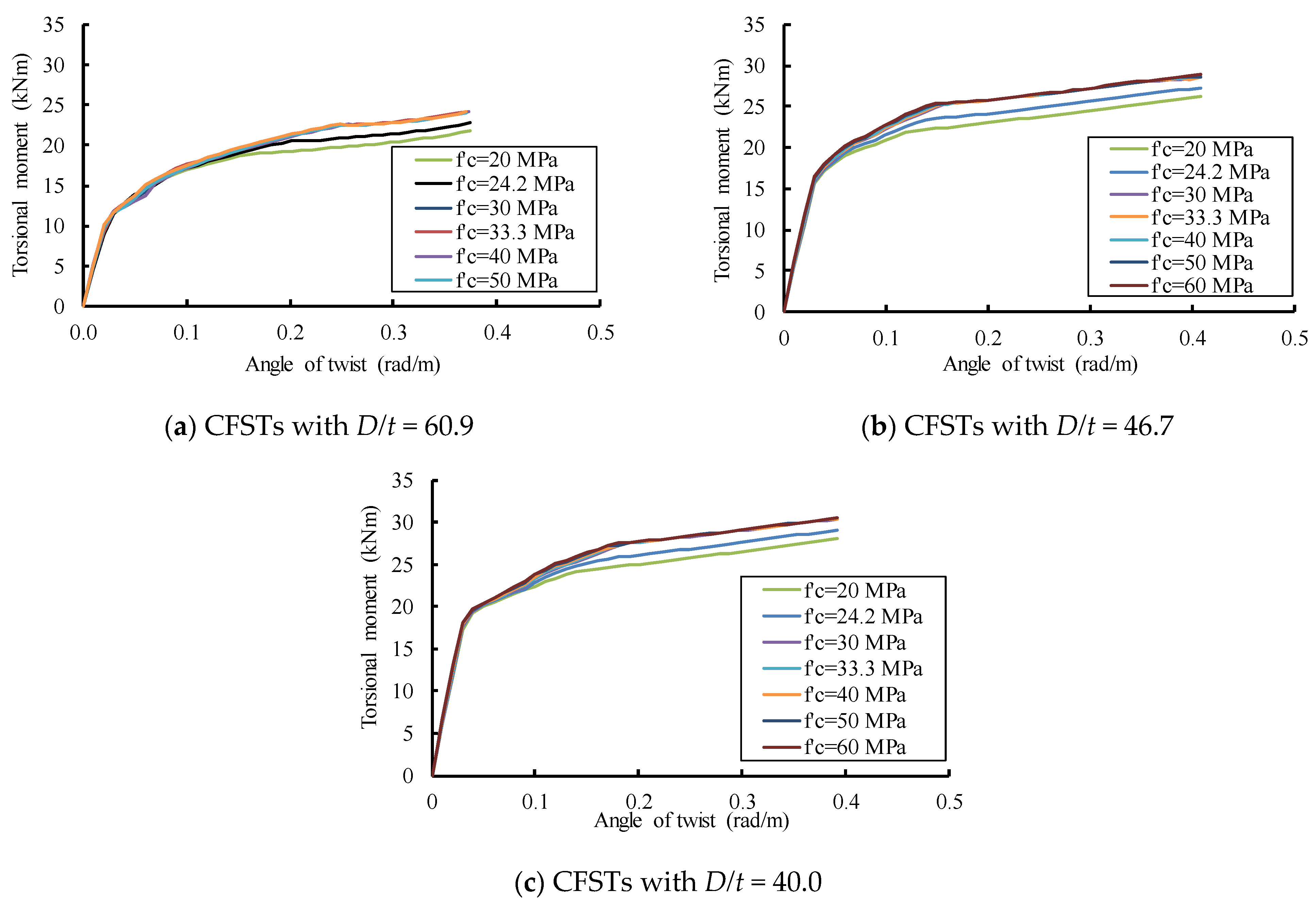


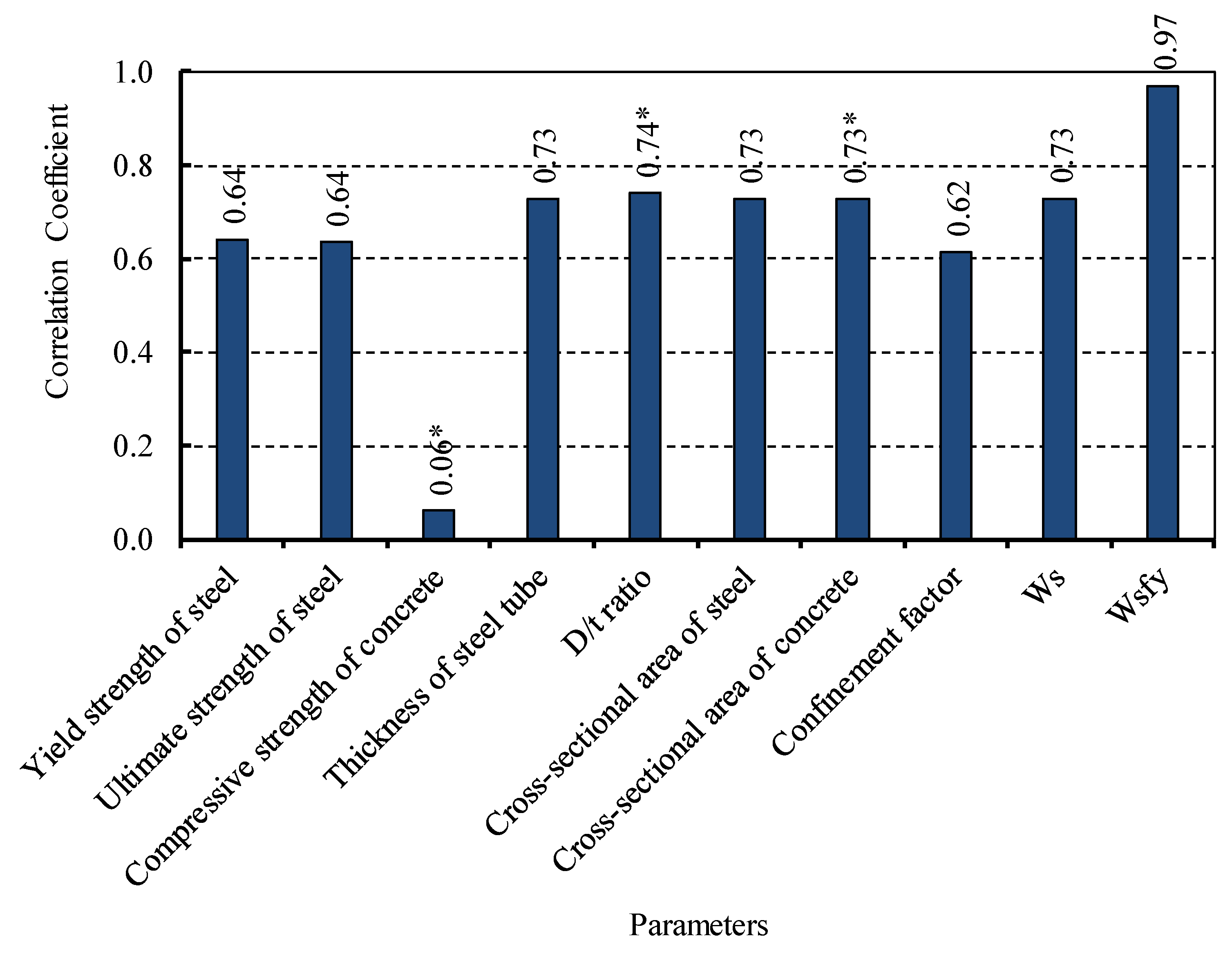
| No. | Subgroup | Dimension D × t × L (mm) | Yield Strength of Steel (MPa) | Ultimate Strength of Steel (MPa) | Compressive Strength of Concrete (MPa) |
|---|---|---|---|---|---|
| 1 | CFST-AN | 140 × 2.3 × 1000 | 302.5 | 406.6 | 24.2 |
| 2 | CFST-BN | 140 × 3.0 × 1000 | 302.5 | 406.6 | 24.2 |
| 3 | CFST-CN | 140 × 3.5 × 1000 | 302.5 | 406.6 | 24.2 |
| 4 | CFST-AH | 140 × 2.3 × 1000 | 302.5 | 406.6 | 33.3 |
| 5 | CFST-BH | 140 × 3.0 × 1000 | 302.5 | 406.6 | 33.3 |
| 6 | CFST-CH | 140 × 3.5 × 1000 | 302.5 | 406.6 | 33.3 |
| No. | Sub Group | t | fy | fu | f′c | D/t | As | Ac | ξ | Ws | Wsfy | Me | ke | kp | Mo | My | Increaseof My |
|---|---|---|---|---|---|---|---|---|---|---|---|---|---|---|---|---|---|
| mm | MPa | MPa | MPa | mm2 | mm2 | mm3 | N.mm | kNm | kNm/rad/m | kNm | % | ||||||
| 1 | CFST-A | 2.3 | 235 | 359.6 | 24.2 | 60.9 | 995.0 | 14,398.8 | 0.671 | 67,397.3 | 15,838,371 | 9.51 | 441.7 | 23.4 | 13.3 | 14.0 | |
| 2 | CFST-A | 2.3 | 345 | 452.0 | 24.2 | 60.9 | 995.0 | 14,398.8 | 0.985 | 67,397.3 | 23,252,076 | 13.10 | 438.0 | 18.5 | 18.6 | 19.5 | 38.8 |
| 3 | CFST-A | 2.3 | 390 | 475.8 | 24.2 | 60.9 | 995.0 | 14,398.8 | 1.114 | 67,397.3 | 26,284,956 | 15.90 | 449.0 | 17.3 | 20.4 | 21.2 | 51.2 |
| 4 | CFST-A | 2.3 | 420 | 500.9 | 24.2 | 60.9 | 995.0 | 14,398.8 | 1.199 | 67,397.3 | 28,306,876 | 16.72 | 424.7 | 17.3 | 20.4 | 21.2 | 51.6 |
| 5 | CFST-A | 2.3 | 302.5 | 406.6 | 20 | 60.9 | 995.0 | 14,398.8 | 1.045 | 67,397.3 | 20,387,690 | 11.58 | 452.6 | 14.7 | 16.1 | 16.7 | |
| 6 | CFST-A | 2.3 | 302.5 | 406.6 | 30 | 60.9 | 995.0 | 14,398.8 | 0.697 | 67,397.3 | 20,387,690 | 11.68 | 469.9 | 22.8 | 16.1 | 16.9 | 1.3 |
| 7 | CFST-A | 2.3 | 302.5 | 406.6 | 40 | 60.9 | 995.0 | 14,398.8 | 0.523 | 67,397.3 | 20,387,690 | 11.78 | 501.2 | 23.1 | 16.0 | 16.7 | 0.4 |
| 8 | CFST-A | 2.3 | 302.5 | 406.6 | 50 | 60.9 | 995.0 | 143,98.8 | 0.418 | 67,397.3 | 20,387,690 | 11.64 | 492.2 | 22.6 | 16.1 | 16.9 | 1.2 |
| 9 | CFST-A | 2.3 | 302.5 | 406.6 | 60 | 60.9 | 995.0 | 14,398.8 | 0.348 | 67,397.3 | 20,387,690 | 11.69 | 504.7 | 21.4 | 16.5 | 17.3 | 3.6 |
| 1 | CFST-B | 3.0 | 235 | 359.6 | 24.2 | 46.7 | 1291.2 | 14,102.6 | 0.889 | 86,593.0 | 20,349,365 | 13.49 | 542.3 | 17.8 | 17.5 | 18.1 | |
| 2 | CFST-B | 3.0 | 345 | 452.0 | 24.2 | 46.7 | 1291.2 | 14,102.6 | 1.305 | 86,593.0 | 29,874,600 | 18.94 | 537.3 | 17.0 | 22.8 | 23.6 | 30.1 |
| 3 | CFST-B | 3.0 | 390 | 475.8 | 24.2 | 46.7 | 1291.2 | 14,102.6 | 1.476 | 86,593.0 | 33,771,286 | 20.41 | 537.3 | 15.2 | 25.1 | 25.8 | 42.5 |
| 4 | CFST-B | 3.0 | 420 | 500.9 | 24.2 | 46.7 | 1291.2 | 14,102.6 | 1.589 | 86,593.0 | 36,369,078 | 20.92 | 537.3 | 13.9 | 26.6 | 27.3 | 50.6 |
| 5 | CFST-B | 3.0 | 302.5 | 406.6 | 20 | 46.7 | 1291.2 | 14,102.6 | 1.385 | 86,593.0 | 26,194,395 | 15.57 | 525.1 | 15.7 | 19.8 | 20.4 | |
| 6 | CFST-B | 3.0 | 302.5 | 406.6 | 30 | 46.7 | 1291.2 | 14,102.6 | 0.923 | 86,593.0 | 26,194,395 | 15.99 | 542.3 | 17.1 | 22.0 | 22.7 | 11.1 |
| 7 | CFST-B | 3.0 | 302.5 | 406.6 | 40 | 46.7 | 1291.2 | 14,102.6 | 0.692 | 86,593.0 | 26,194,395 | 16.20 | 551.5 | 16.9 | 22.1 | 22.8 | 11.7 |
| 8 | CFST-B | 3.0 | 302.5 | 406.6 | 50 | 46.7 | 1291.2 | 14,102.6 | 0.554 | 86,593.0 | 26,194,395 | 16.39 | 561.8 | 16.5 | 22.3 | 22.9 | 12.3 |
| 9 | CFST-B | 3.0 | 302.5 | 406.6 | 60 | 46.7 | 1291.2 | 14,102.6 | 0.462 | 86,593.0 | 26,194,395 | 16.52 | 568.4 | 16.6 | 22.3 | 23.0 | 11.4 |
| 1 | CFST-C | 3.5 | 235 | 359.6 | 24.2 | 40.0 | 1500.9 | 13,892.9 | 1.049 | 99,940.9 | 23,486,113 | 15.04 | 605.3 | 20.7 | 18.3 | 18.9 | |
| 2 | CFST-C | 3.5 | 345 | 452.0 | 24.2 | 40.0 | 1500.9 | 13,892.9 | 1.540 | 99,940.9 | 34,479,612 | 21.32 | 598.5 | 19.1 | 24.6 | 25.4 | 34.2 |
| 3 | CFST-C | 3.5 | 390 | 475.8 | 24.2 | 40.0 | 1500.9 | 13,892.9 | 1.741 | 99,940.9 | 38,976,953 | 22.92 | 585.2 | 17.4 | 27.1 | 28.0 | 47.9 |
| 4 | CFST-C | 3.5 | 420 | 500.9 | 24.2 | 40.0 | 1500.9 | 13,892.9 | 1.875 | 99,940.9 | 41,975,180 | 23.29 | 590.2 | 16.2 | 28.8 | 29.6 | 56.6 |
| 5 | CFST-C | 3.5 | 302.5 | 406.6 | 20 | 40.0 | 1500.9 | 13,892.9 | 1.634 | 99,940.9 | 30,232,124 | 17.36 | 584.5 | 15.6 | 21.9 | 22.5 | |
| 6 | CFST-C | 3.5 | 302.5 | 406.6 | 30 | 40.0 | 1500.9 | 13,892.9 | 1.089 | 99,940.9 | 30,232,124 | 17.85 | 602.8 | 20.1 | 23.0 | 23.8 | 5.6 |
| 7 | CFST-C | 3.5 | 302.5 | 406.6 | 40 | 40.0 | 1500.9 | 13,892.9 | 0.817 | 99,940.9 | 30,232,124 | 17.97 | 611.1 | 18.3 | 23.6 | 24.3 | 7.8 |
| 8 | CFST-C | 3.5 | 302.5 | 406.6 | 50 | 40.0 | 1500.9 | 13,892.9 | 0.654 | 99,940.9 | 30,232,124 | 18.05 | 618.0 | 19.9 | 23.2 | 23.9 | 6.3 |
| 9 | CFST-C | 3.5 | 302.5 | 406.6 | 60 | 40.0 | 1500.9 | 13,892.9 | 0.545 | 99,940.9 | 30,232,124 | 18.15 | 623.4 | 19.3 | 23.3 | 24.1 | 6.5 |
| Parameter | Absolute Correlation Coefficient | Order |
|---|---|---|
| Wsfy | 0.9709 | 1 |
| D/t | 0.7412 | 2 |
| Ws | 0.7299 | 3 |
| As | 0.7291 | 4 |
| Ac | 0.7291 | 5 |
| t | 0.7288 | 6 |
| fy | 0.6425 | 7 |
| fu | 0.6364 | 8 |
| ξ | 0.6152 | 9 |
| f′c | 0.0608 | 10 |
Publisher’s Note: MDPI stays neutral with regard to jurisdictional claims in published maps and institutional affiliations. |
© 2021 by the authors. Licensee MDPI, Basel, Switzerland. This article is an open access article distributed under the terms and conditions of the Creative Commons Attribution (CC BY) license (https://creativecommons.org/licenses/by/4.0/).
Share and Cite
Le, K.B.; Cao, V.V. Numerical Study of Circular Concrete Filled Steel Tubes Subjected to Pure Torsion. Buildings 2021, 11, 397. https://doi.org/10.3390/buildings11090397
Le KB, Cao VV. Numerical Study of Circular Concrete Filled Steel Tubes Subjected to Pure Torsion. Buildings. 2021; 11(9):397. https://doi.org/10.3390/buildings11090397
Chicago/Turabian StyleLe, Khanh Ba, and Vui Van Cao. 2021. "Numerical Study of Circular Concrete Filled Steel Tubes Subjected to Pure Torsion" Buildings 11, no. 9: 397. https://doi.org/10.3390/buildings11090397
APA StyleLe, K. B., & Cao, V. V. (2021). Numerical Study of Circular Concrete Filled Steel Tubes Subjected to Pure Torsion. Buildings, 11(9), 397. https://doi.org/10.3390/buildings11090397






